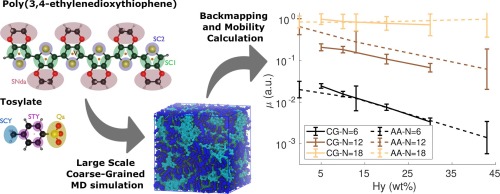当前位置:
X-MOL 学术
›
Comp. Mater. Sci.
›
论文详情
Our official English website, www.x-mol.net, welcomes your
feedback! (Note: you will need to create a separate account there.)
Large scale mobility calculations in PEDOT (Poly(3,4-ethylenedioxythiophene)): Backmapping the coarse-grained MARTINI morphology
Computational Materials Science ( IF 3.1 ) Pub Date : 2020-06-01 , DOI: 10.1016/j.commatsci.2020.109678 Nicolas Rolland , Mohsen Modarresi , Juan Felipe Franco-Gonzalez , Igor Zozoulenko
Computational Materials Science ( IF 3.1 ) Pub Date : 2020-06-01 , DOI: 10.1016/j.commatsci.2020.109678 Nicolas Rolland , Mohsen Modarresi , Juan Felipe Franco-Gonzalez , Igor Zozoulenko

|
Abstract Designing new high performances materials based on conducting polymers necessitates the development of multiscale models to investigate the charge transport in large realistic systems. In this work, we utilize Coarse-Grained (CG) Molecular Dynamics (MD) simulations to generate morphologies of Poly(3,4-ethylenedioxythiophene) (PEDOT) doped with Tosylate (TOS) ions, and we develop a backmapping protocol to retrieve the atomistic details of the molecules afterwards. We demonstrate that the proposed protocol corrects for the nanostructure distortions induced by Coarse-Graining the system, namely a wrong density and an over-estimated π - π stacking distance. Quantum chemical calculations are performed on the systems obtained after backmapping in order to calculate hopping rates for charge transport, and charge mobilities as a function of the PEDOT chain length and hydration level are then calculated by solving a master equation for transport. The results are identical to the calculations performed on PEDOT morphologies obtained by direct All-Atomistic (AA) MD simulations: the mobility increases with the chain length and decreases with the hydration level, this last effect being more pronounced for short chains. This definitely shows that the workflow CG MD → backmapping → mobility calculations is in position to calculate charge mobility in PEDOT based materials, paving the way for theoretical investigations of transport in more complex materials such as PEDOT doped with Polystyrene Sulfonate (PSS).
中文翻译:

PEDOT(聚(3,4-亚乙基二氧噻吩))中的大规模迁移率计算:粗粒度 MARTINI 形态的反向映射
摘要 设计基于导电聚合物的新型高性能材料需要开发多尺度模型来研究大型现实系统中的电荷传输。在这项工作中,我们利用粗粒 (CG) 分子动力学 (MD) 模拟来生成掺杂甲苯磺酸盐 (TOS) 离子的聚 (3,4-亚乙基二氧噻吩) (PEDOT) 的形态,我们开发了一个反向映射协议来检索之后分子的原子细节。我们证明所提出的协议纠正了由粗粒度系统引起的纳米结构扭曲,即错误的密度和高估的 π - π 堆叠距离。在反向映射后获得的系统上执行量子化学计算,以计算电荷传输的跳跃率,然后通过求解传输的主方程来计算作为 PEDOT 链长度和水合水平函数的电荷迁移率。结果与对通过直接全原子 (AA) MD 模拟获得的 PEDOT 形态进行的计算相同:流动性随着链长度的增加而增加,随着水合水平的增加而减少,最后一种效果对于短链更为明显。这清楚地表明,工作流程 CG MD → 背映射 → 迁移率计算适合计算基于 PEDOT 的材料中的电荷迁移率,为更复杂材料(例如掺杂聚苯乙烯磺酸 (PSS) 的 PEDOT 中的迁移的理论研究铺平了道路。结果与对通过直接全原子 (AA) MD 模拟获得的 PEDOT 形态进行的计算相同:流动性随着链长度的增加而增加,随着水合水平的增加而减少,最后一种效果对于短链更为明显。这清楚地表明,工作流程 CG MD → 背映射 → 迁移率计算适合计算基于 PEDOT 的材料中的电荷迁移率,为更复杂材料(例如掺杂聚苯乙烯磺酸 (PSS) 的 PEDOT 中的迁移的理论研究铺平了道路。结果与对通过直接全原子 (AA) MD 模拟获得的 PEDOT 形态进行的计算相同:流动性随着链长度的增加而增加,随着水合水平的增加而减少,最后一种效果对于短链更为明显。这清楚地表明,工作流程 CG MD → 背映射 → 迁移率计算适合计算基于 PEDOT 的材料中的电荷迁移率,为更复杂材料(例如掺杂聚苯乙烯磺酸 (PSS) 的 PEDOT 中的迁移的理论研究铺平了道路。
更新日期:2020-06-01
中文翻译:

PEDOT(聚(3,4-亚乙基二氧噻吩))中的大规模迁移率计算:粗粒度 MARTINI 形态的反向映射
摘要 设计基于导电聚合物的新型高性能材料需要开发多尺度模型来研究大型现实系统中的电荷传输。在这项工作中,我们利用粗粒 (CG) 分子动力学 (MD) 模拟来生成掺杂甲苯磺酸盐 (TOS) 离子的聚 (3,4-亚乙基二氧噻吩) (PEDOT) 的形态,我们开发了一个反向映射协议来检索之后分子的原子细节。我们证明所提出的协议纠正了由粗粒度系统引起的纳米结构扭曲,即错误的密度和高估的 π - π 堆叠距离。在反向映射后获得的系统上执行量子化学计算,以计算电荷传输的跳跃率,然后通过求解传输的主方程来计算作为 PEDOT 链长度和水合水平函数的电荷迁移率。结果与对通过直接全原子 (AA) MD 模拟获得的 PEDOT 形态进行的计算相同:流动性随着链长度的增加而增加,随着水合水平的增加而减少,最后一种效果对于短链更为明显。这清楚地表明,工作流程 CG MD → 背映射 → 迁移率计算适合计算基于 PEDOT 的材料中的电荷迁移率,为更复杂材料(例如掺杂聚苯乙烯磺酸 (PSS) 的 PEDOT 中的迁移的理论研究铺平了道路。结果与对通过直接全原子 (AA) MD 模拟获得的 PEDOT 形态进行的计算相同:流动性随着链长度的增加而增加,随着水合水平的增加而减少,最后一种效果对于短链更为明显。这清楚地表明,工作流程 CG MD → 背映射 → 迁移率计算适合计算基于 PEDOT 的材料中的电荷迁移率,为更复杂材料(例如掺杂聚苯乙烯磺酸 (PSS) 的 PEDOT 中的迁移的理论研究铺平了道路。结果与对通过直接全原子 (AA) MD 模拟获得的 PEDOT 形态进行的计算相同:流动性随着链长度的增加而增加,随着水合水平的增加而减少,最后一种效果对于短链更为明显。这清楚地表明,工作流程 CG MD → 背映射 → 迁移率计算适合计算基于 PEDOT 的材料中的电荷迁移率,为更复杂材料(例如掺杂聚苯乙烯磺酸 (PSS) 的 PEDOT 中的迁移的理论研究铺平了道路。











































 京公网安备 11010802027423号
京公网安备 11010802027423号